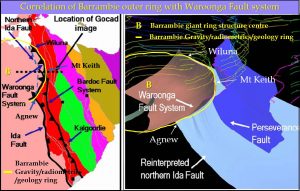YB #1. Impact structure or Archaean superplume? The 420km diameter Barrambie Giant Ring Structure as observed in the Yilgarn geological data.

Summary
Impact?
Archaean GRS have not been the subject of any major research studies in the Yilgarn – or the world. Tim O’Driscoll is one of the few researchers that had given serious attention to these easily observed features (O’Driscoll and Campbell 1997). Once the technique of defining the structure has been mastered the problem it is not the inability to find GRS but to sort out the characteristics and relative age of the large number of GRSs that are observed.
This paper is the first in a series that will document the Barrambie giant ring structure (GRS) in the Yilgarn Craton as observed in various geoscientific data.
The centre of the Barrambie giant ring structure (GRS) is located at 27˚ 40’S and 119˚09’E about 70 km NNW of Sandstone.
The Barrambie giant ring structure cuts across all regional geology and there is no large-scale evidence that it is a product of the regional geology.
Residual gravity highlights near surface greenstones that follow sections of the Barrambie rings suggesting that they were intruded along these rings.
Barrambie GRS can be observed in the surficial geology and radiometric data. These rings correlate with the gravity rings.
The overprinting relationships of the Barrambie GRS suggests that it is younger than both Malgar and Watchorn GRSs but is older than 2.9 Ga. However, the rings are more geologically disturbed (and harder to observe) than the rings of Watchorn, Norseman, Cauden and Plumridge. This may be because the NW Yilgarn is the oldest area, has had more surface greenstone crust eroded and thus undergone more prolonged deformation and metamorphism.
The Waroonga Fault system (the eastern Wiluna to Agnew ring) has been studied to understand the origin of the Barrambie GRS. This fault system has the bowl shape associated with an impact structure which is different from the inverted bowl shape structures which form over a superplume or other magmatic upwellings.
The Barrambie GRS ties together the structural history of the Murchison and North East Yilgarn areas.
For more information click the arrow below —- Pass it on to your discerning colleagues!
| YB#1 Barrambie GRS introduction paper 9 Nov 2017.pdf | 3 MB |

